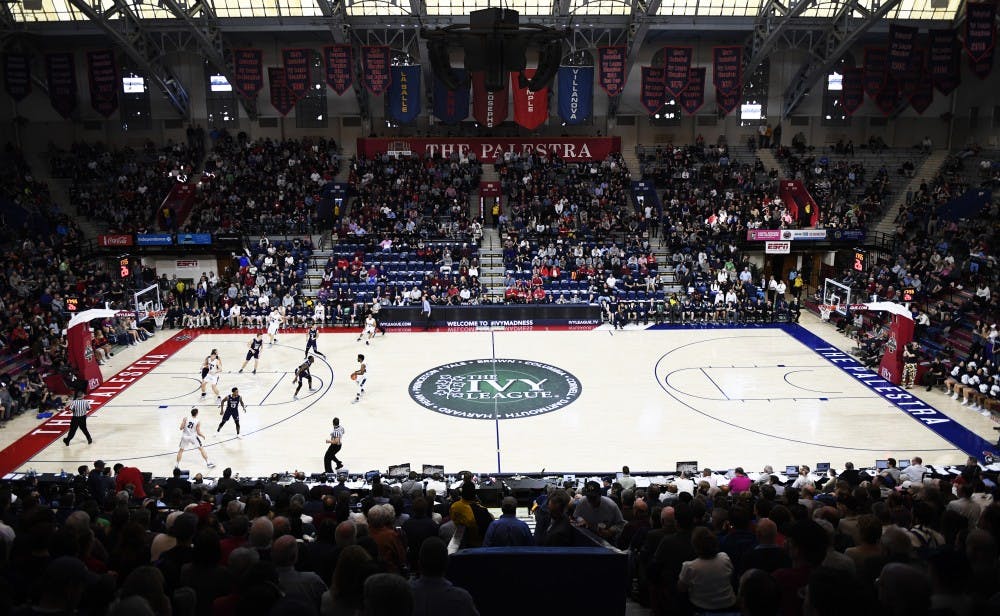The best two teams in the Ivy League will meet again, and this time they're playing for keeps.
Penn men’s basketball dominated Yale out of the gate, just a week after a loss to the Elis prevented the Quakers from claiming the Ancient Eight title outright. Now, Penn will meet co-champion Harvard in the conference final.
Here are four takeaways from the Red and Blue’s 78-50 semifinal win:
The home-court advantage is real
Much has been made about the Ivy League Tournament’s location. While the consensus among the coaches and the media is that the tournament is a net positive for the conference, there has been controversy surrounding the potential competitive advantage conferred.
Coaches like Princeton women’s coach Courtney Banghart and Yale men’s coach James Jones, and members of the media, have expressed concerns about granting Penn home-court advantage should the Palestra continue to be the home of the tournament.
Those concerns were vindicated.

RELATED:
Coach Steve Donahue highlights multiple All-Ivy recognitions for Penn basketball
Three things to know before Penn men’s basketball Ivy Madness match-up with Yale
Penn men's basketball cruises past Yale, will face Harvard for NCAA Tournament bid
Last year, Penn didn’t have much of an advantage in terms of crowd size — the newness of the tournament coupled with the proximity of Princeton meant that the Palestra was packed with fans of both schools.
This year, overall attendance is noticeably lower. And the loss of attendance, thus far, has come more from the other schools’ fans than from Penn’s. The empty seats against Yale were concentrated on their half of the court; there was virtually no student section behind the Bulldog basket.
The result: Penn got a home-court boost, and it paid off.
AJ Brodeur more than deserves all the accolades he has earned
The sophomore forward was the catalyst for Penn’s offensive domination, particularly in the first half. When the Elis refusing to double-team, Penn’s first team All-Ivy representative made them pay.
Brodeur finished with a whopping 25 points and 10 rebounds in 27 minutes of playing time. The majority of those buckets came on the interior, as Brodeur was able to outmaneuver the Bulldogs to get open on the low block.

“Early on in the game I found that I was being single covered on the post, I was able to get to my go-to moves with relative ease. My teammates saw that, and they kept feeding me,” Brodeur said. “Normally we expect a defensive change, like a double-team … but down the stretch, I didn’t feel to much of a change defensively on Yale’s part because we were able to keep pounding it down low.”
With Yale’s first team All-Ivy guard Miye Oni held to just five points — more on that later — Brodeur was easily the best player on the court.
Penn’s offense requires — and maintains — smooth ball movement
We’ve known for weeks just how balanced this Penn offense is. Offensive efficiency for balanced teams requires good passing to find the open shot. Against Yale, that passing was as effective as it's been all season.
There was one possession in particular late in the first half that illustrates this point. A Penn guard brought the ball up the court in transition down the right sideline. Yale’s defense was disorganized in transition, causing the on-ball defender to over-commit. Three passes later, the Quakers had a three-on-one in the post. When some teams would try to overpower the lone defender, Penn completed two easy passes to get Brodeur a point-blank layup.
The whole play took only a couple of seconds, but the unselfishness and vision of all five players on the court, bigs included, turned a contested shot into an easy two points. Over the course of the game, plays like that opened up the floor and created offense out of nothing.

Defense wins championships
Penn’s best games all year have been on the lower scoring side of things. The Quakers operate at their best when they are able to lean on their defense to create transition opportunities. That means creating turnovers, limiting their opponent’s effectiveness from the three-point line, and bottling up their best player.
The Red and Blue did all three against the Elis. They forced seven turnovers, including several in transition that turned easy points for Yale into a possession the other way. They limited Yale to just 4 of 24 from beyond the arc, eliminating any possibility for the Bulldogs to climb back into the game.
Yale’s leading scorer this season was Oni, who averaged 15.5 points per game in the regular season. Today, he was held scoreless in the first half (shooting 0 for 10 from the floor) and finished with just five points. Part of that was due to luck — Oni missed a slew of open looks that he typically makes — but credit the Penn defense, especially junior Antonio Woods, with shutting down Yale’s biggest weapon.




